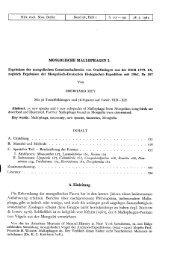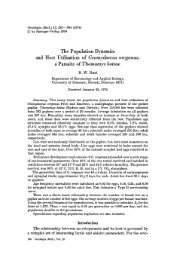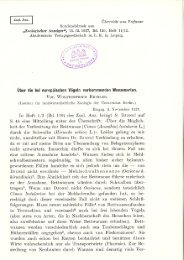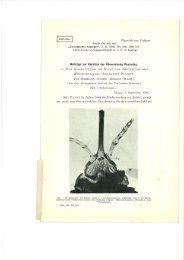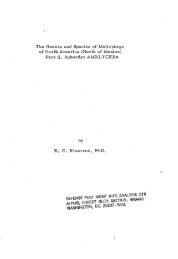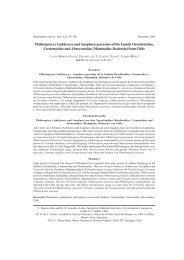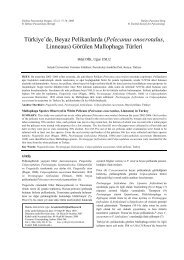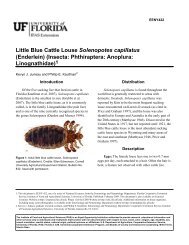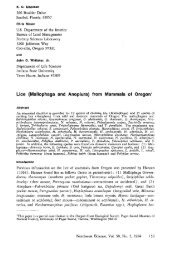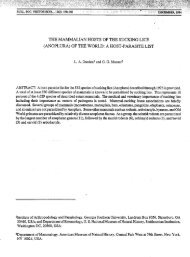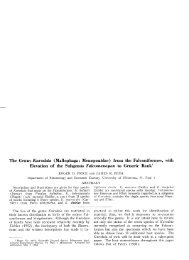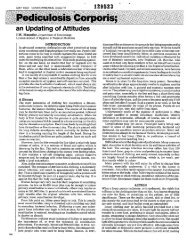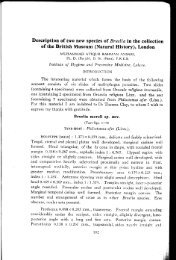The Geographical and Ecological Distribution of Arboreal Psocoptera
The Geographical and Ecological Distribution of Arboreal Psocoptera
The Geographical and Ecological Distribution of Arboreal Psocoptera
Create successful ePaper yourself
Turn your PDF publications into a flip-book with our unique Google optimized e-Paper software.
Annu. Rev. Entomol. 1985.30:175-196. Downloaded from arjournals.annualreviews.org<br />
by Mr. Bas van Berkum on 10/10/07. For personal use only.<br />
Annual Reviews<br />
www.annualreviews.org/aronline<br />
192 THORNTON<br />
quantity <strong>of</strong> microepiphytes increase with altitude, thus allowing the coexistence<br />
<strong>of</strong> a greater number <strong>of</strong> species (although modification <strong>of</strong> lowlan,ds by man<br />
is also an important factor). <strong>The</strong>re have been no specialist studies <strong>of</strong> the vertical<br />
distribution <strong>of</strong> psocid food on trees, but Turner (97) found significan~Ily greater<br />
epiphyte densities above 1.5 m than nearer to the ground.<br />
Several species <strong>of</strong> some eight families are known to be specialist exploiters<br />
<strong>of</strong> dying <strong>and</strong> dead vegetation <strong>and</strong> in fact can be collected by first: breaking<br />
branches <strong>and</strong> then returning later to collect a sample. Ectopsocus briggsi is a<br />
typical example. Turner (96) noted that this small species, which feeds on the<br />
spores <strong>and</strong> hyphae <strong>of</strong> decomposer fungi, had the greatest biomass <strong>of</strong> any psocid<br />
in the late summer in one <strong>of</strong> the three years <strong>of</strong> his study, yet was otherwise rare.<br />
He ascribed this to unusually moist conditions in late summer <strong>of</strong> that year,<br />
following a summer drought, that favored the development <strong>of</strong> fungi on dead<br />
plant material. Unpredictable climatic phenomena such as this as well as<br />
r<strong>and</strong>om local disturbances to the canopy will have an important effect on the<br />
distribution <strong>of</strong> such opportunistic species.<br />
HUMIDITY Humidity clearly plays a key role in the life <strong>of</strong> psocids <strong>and</strong> in<br />
aboreal species its effects may be related to food supply. Liposcelis species are<br />
capable <strong>of</strong> absorbing water vapor from an atmosphere down to 58% relative<br />
humidity (R.H.); below 58% R.H. water loss leads to death. Rudolph (66)<br />
demonstrated this process in 22 psocid species <strong>of</strong> diverse habitats <strong>and</strong> representing<br />
all major groups. <strong>The</strong> rates <strong>of</strong> both water loss <strong>and</strong> uptake were shown to<br />
be markedly high for arthropods, <strong>and</strong> the uptake-to-loss ratio, a measure <strong>of</strong> the<br />
efficiency <strong>of</strong> the water balance mechanism, was among the highest <strong>of</strong> all<br />
arthropods studied. This ability appears to be characteristic <strong>of</strong> the order,<br />
unrelated to specific environmental conditions. Differences in critical equilibrium<br />
humidities (58-85%) <strong>and</strong> water loss <strong>and</strong> uptake rates were not correlated<br />
with habitat, apart from the observation that domestic <strong>and</strong> nidicolous species<br />
have lower critical values (58-76%) than arboreal species (76-85%). Intensive<br />
<strong>and</strong> extensive studies <strong>of</strong> the microhabitats <strong>of</strong> species that differ greatly in<br />
uptake/loss ratios are now needed.<br />
<strong>The</strong> mechanism’s operation was shown to be highly dependent on food<br />
supply, particularly in arboreal species in which food storage ability is evidently<br />
poor <strong>and</strong> the physiological mechanism is upset unless the insects can feed at<br />
short intervals. <strong>The</strong> indications are that above about 75% R.H., food supply,<br />
rather than relative humidity itself, may be the limiting factor.<br />
AIR POLLUTION AND PSOCID DISTRIBUTION Gilbert (28) has den~tonstrated<br />
the indirect effects (through microepiphytes) <strong>of</strong> air pollution on the distribution<br />
<strong>of</strong> corticolous psocids in the Newcastle area <strong>of</strong> the industrial north <strong>of</strong> Engl<strong>and</strong>.<br />
He showed a very high correlation between the diversity <strong>of</strong> the psocid fauna <strong>of</strong>



